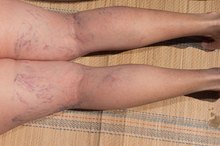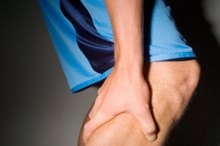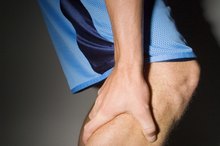What does fact checked mean?
At Healthfully, we strive to deliver objective content that is accurate and up-to-date. Our team periodically reviews articles in order to ensure content quality. The sources cited below consist of evidence from peer-reviewed journals, prominent medical organizations, academic associations, and government data.
The information contained on this site is for informational purposes only, and should not be used as a substitute for the advice of a professional health care provider. Please check with the appropriate physician regarding health questions and concerns. Although we strive to deliver accurate and up-to-date information, no guarantee to that effect is made.
Saphenous Vein Pain When Walking
The greater saphenous vein is a large vein in the front of your leg that stretches from your foot to your groin. Its purpose of the greater saphenous vein is to deliver blood that has been drained of oxygen through one-way valves to the deep femoral vein, which then moves the blood back to the heart. If the valves fail, blood pooling can occur, a condition known as varicose veins; varicose veins are among many potential causes of pain in the saphenous vein while walking. If you experience saphenous vein pain when walking, consult your doctor.
If you are experiencing serious medical symptoms, seek emergency treatment immediately.
Venous Reflux Disease
Venous reflux disease that occurs in the greater saphenous vein is a type of venous insufficiency that prevents the proper flow of blood that needs oxygen up from the lower extremities. The valves that move blood flow up don't function properly, causing varicose veins. According to VNUS Medical Technologies, approximately 25 million Americans have varicose veins, a progressive disease that can range in severity.
Varicose Veins
Can Walking Improve Circulation?
Learn More
Varicose veins can vary in severity and in their location in your lower leg or legs. Spider veins, for example, are mild and might only be a cosmetic problem. If you only have pain in one leg or saphenous vein when you walk, the condition may only be affecting that leg.
Treatment
Treatment for varicose veins is typically non-invasive. If you have varicose veins that don't respond to self-care measures or the condition is severe with rapid progression, your doctor may suggest one of several available treatments.
Get Up and Move
Blood Clot After Surgery Symptoms
Learn More
Walking may be good for saphenous leg pain caused by varicose veins. According to MayoClinic.com, walking gets blood circulating in your legs. Talk to your doctor about your saphenous vein pain when walking and make sure your activity level is appropriate.
Related Articles
References
- MayoClinic.com; Varicose Veins; Jan. 12, 2011
- Raetz J, Wilson M, Collins K. Varicose veins: Diagnosis and treatment. Am Fam Physician. 2019;99(11):682-688.
- Critello CD, Pullano SA, Matula TJ, De Franciscis S, Serra R, Fiorillo AS. Recent developments on foaming mechanical and electronic techniques for the management of varicose veins. Expert Rev Med Devices. 2019;16(11):931-940. doi:10.1080/17434440.2019.1682549
- Epstein D, Onida S, Bootun R, Ortega-Ortega M, Davies AH. Cost-effectiveness of current and emerging treatments of varicose veins. Value Health. 2018;21(8):911-920. doi:10.1016/j.jval.2018.01.012
- American Academy of Dermatology. Leg veins: Why they appear and how dermatologists treat them.
Writer Bio
Jackie Carmichael has been a freelance writer for more than 10 years. Her work has appeared in "Woman's World" and "American Baby" magazines. Carmichael is a licensed registered nurse and has worked in fields related to cardiovascular health and psychiatry. She also holds a Bachelor of Arts in journalism from The Ohio State University.









